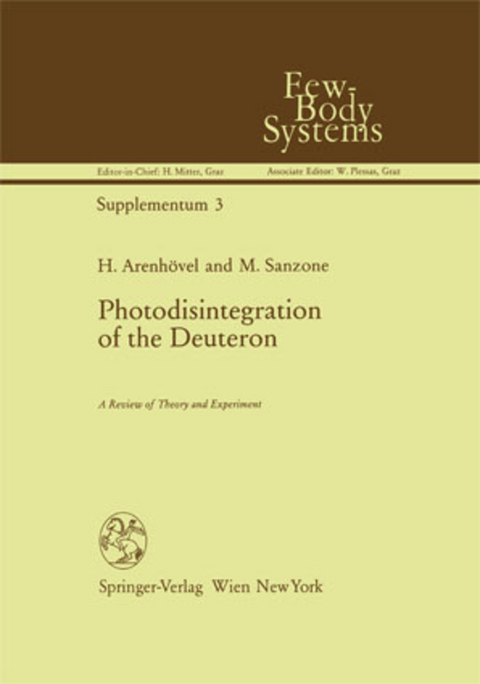
Photodisintegration of the Deuteron
Springer Wien (Verlag)
978-3-7091-7387-9 (ISBN)
1 Introduction.- 2 Elementary theory and brief history.- 3 Formal theory for two-particle channels.- 3.1 Kinematics.- 3.2 The T-matrix.- 3.3 Density matrices.- 3.4 Cross section and polarization observables.- 3.5 Multipole decomposition and angular distributions.- 4 Methods of calculation for the T-matrix.- 4.1 Non-relativistic approach.- 4.2 Meson-exchange currents and isobar configurations.- 4.3 Relativistic effects.- 4.4 The diagrammatic approach.- 4.5 Covariant theory and dispersion relations.- 5 Unpolarized and polarized beam sources.- 5.1 Continuous bremsstrahlung and the monitoring problem.- 5.2 Monochromatic and quasi-monochromatic photon beams.- 5.3 Inverse reaction and detailed balance.- 5.4 Polarized beam sources.- 6 Experimental results for two-particle break-up.- 6.1 Total and differential cross sections.- 6.2 Information from analysis of all available experiments.- 6.3 Results from selected experiments.- 6.4 Experimental results for polarization observables.- 7 Comparison of theory and experiment.- 7.1 Total cross section and sum rules.- 7.2 Angular distributions.- 7.3 Differential cross section at 0° and 180°.- 7.4 Polarization observables.- 8 Conclusion and outlook.- References.
| Erscheint lt. Verlag | 5.10.2012 |
|---|---|
| Reihe/Serie | Few-Body Systems |
| Zusatzinfo | VII, 183 p. |
| Verlagsort | Vienna |
| Sprache | englisch |
| Maße | 178 x 254 mm |
| Gewicht | 382 g |
| Themenwelt | Naturwissenschaften ► Physik / Astronomie ► Atom- / Kern- / Molekularphysik |
| Naturwissenschaften ► Physik / Astronomie ► Plasmaphysik | |
| Schlagworte | cross section • Decomposition • degrees of freedom • Dispersion • Distribution • Energy • Experiment • nuclear physics • Nuklearphysik • paper • Photon • Physics • polarization • Radiation • System |
| ISBN-10 | 3-7091-7387-6 / 3709173876 |
| ISBN-13 | 978-3-7091-7387-9 / 9783709173879 |
| Zustand | Neuware |
| Informationen gemäß Produktsicherheitsverordnung (GPSR) | |
| Haben Sie eine Frage zum Produkt? |
aus dem Bereich


